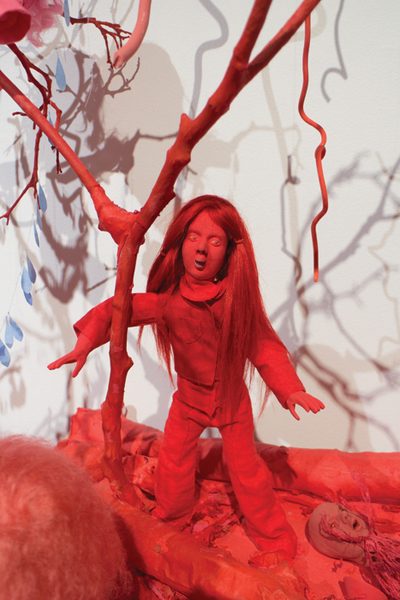Elizabeth Phelps Meyer: Metanoia

Elizabeth Phelps Meyer, red puppet in Metanoia exhibit, 2015, handmade paper (cotton abaca, Thai kozo), branches, cut paper, ink, low fire clay, underglaze, mohair, fabric, thread, wire; installation. Photo courtesy of Real Art Ways.
Gallery installations are theatrical spaces waiting to come alive. Immersed in Elizabeth Phelps Meyer’s carefully staged, solo exhibition Metanoia, defined by the artist as a “transformative change of heart, especially a spiritual conversion,” we imagine ourselves in puppet-maker Geppetto’s workshop, artist giving breath to humble materials.
Metanoia consists of Colornests, a stop-motion video trilogy of Meyer’s handcrafted marionettes as they are being constructed and endowed with personality—some waiting to be painted or staring at their reflections, others interacting and cuddling
—set inside an imaginary art gallery; a white and crimson-hued fantasy forest, its haunting landscape inhabited by marionettes in various postures and costumes, some balanced on red branches, others beckoning or buried in red hand-painted leaves; and 40 feet of white shelving holding hand-thrown bowls, containing red sand and remnants of clay suggesting a fractured landscape.
Meyer’s “performing objects,” including 1,080 wide-cupped ceramic bowls, each unique, beckon for attention in unexpected ways. A viewer’s attention is also held by the visceral power of the blood reds dominating this three-part mixed-media presentation.
There is crimson, the color of robes worn by Buddhist monks and nuns, and by implication the goal of spiritual transformation following cycles of reincarnation and spiritual purification. There is also the slightly lighter vermilion, alluding to powder adorning sculptures at sacred Nepalese sites. In this sense, each of the ceramic bowls is an intimate, vermilion-filled sculpture.
Meyer’s background includes performance, filmmaking, sculpture, painting and an undergraduate degree from Brown University in Visual Arts and Religious Studies. She also spent a sabbatical year studying classical Tibetan painting in Nepal, practicing meditation in Myanmar and traveling in Thailand. Each of these influences, or practices, is present in this gem of an exhibition.
Metanoia culminates January 16 when, in homage to Nepal’s 2015 earthquake, Meyer performs a “gift exchange,” distributing bowls from the installation to benefit a Nepalese monastery and nunnery damaged by the earthquake. Gifting the bowls, Meyer says, is a “reminder of the fragility of our world, and an opportunity for people to practice generosity themselves.”
